Analysis and Report on Emotional Intelligence in the Workplace
VerifiedAdded on 2020/03/16
|8
|1812
|484
Report
AI Summary
This report offers an in-depth analysis of emotional intelligence within a workplace setting, focusing on the deterioration observed among employees. The author utilizes SWOT analysis to assess their own emotional intelligence and that of their colleagues, identifying personality types and emotional strengths and weaknesses. The report explores stressors, emotional states, and triggers that can cause heightened emotional responses, as well as strategies for managing these and promoting positive outcomes. It also examines the influence of staff culture and diversity on emotions and discusses the need for flexibility and adaptability in managing emotional cues and cultural issues. The report incorporates personal examples and insights, offering a practical understanding of emotional intelligence principles in a professional environment, with references to key researchers in the field such as Goleman, Mayer, and Salovey.
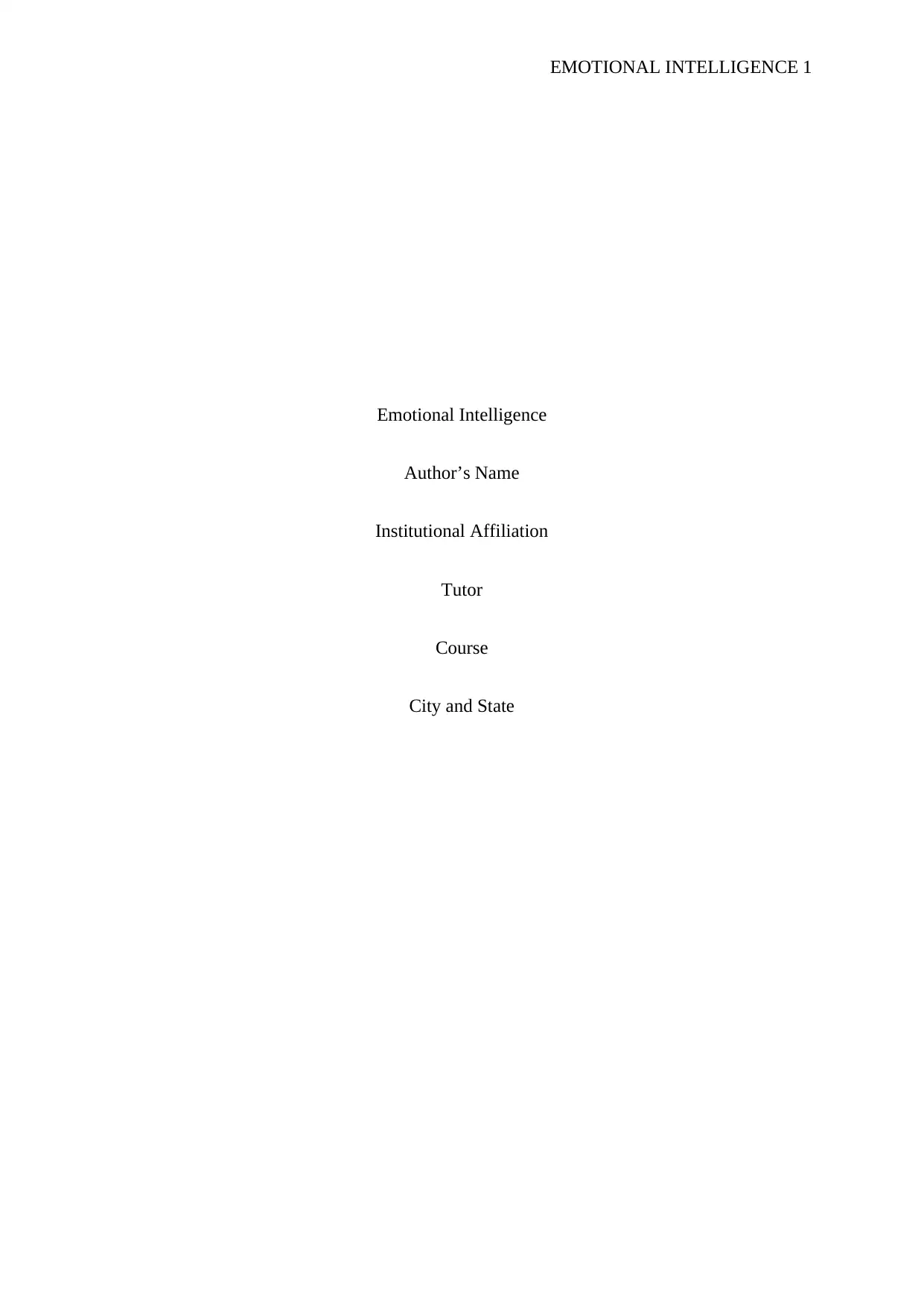
EMOTIONAL INTELLIGENCE 1
Emotional Intelligence
Author’s Name
Institutional Affiliation
Tutor
Course
City and State
Emotional Intelligence
Author’s Name
Institutional Affiliation
Tutor
Course
City and State
Paraphrase This Document
Need a fresh take? Get an instant paraphrase of this document with our AI Paraphraser
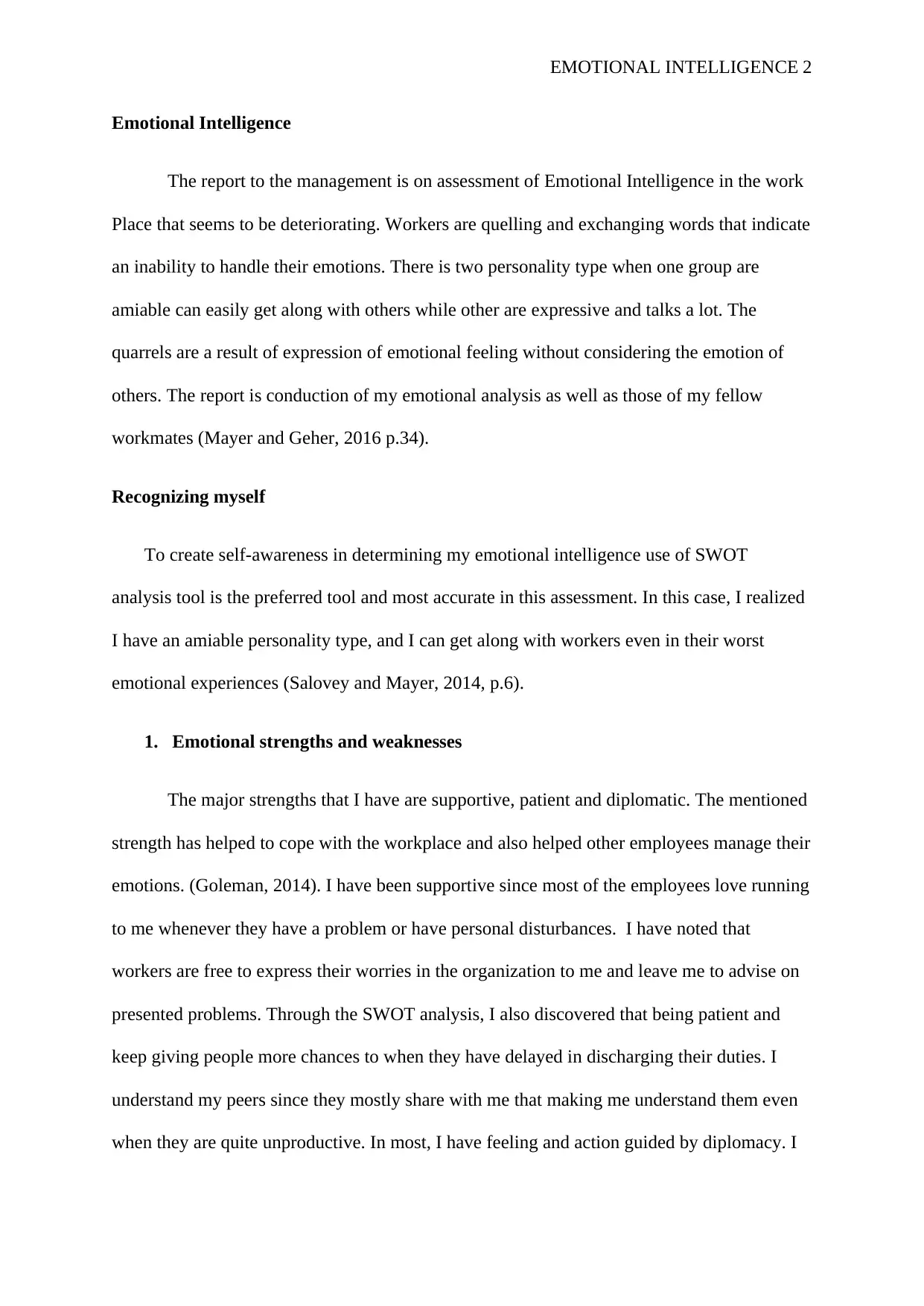
EMOTIONAL INTELLIGENCE 2
Emotional Intelligence
The report to the management is on assessment of Emotional Intelligence in the work
Place that seems to be deteriorating. Workers are quelling and exchanging words that indicate
an inability to handle their emotions. There is two personality type when one group are
amiable can easily get along with others while other are expressive and talks a lot. The
quarrels are a result of expression of emotional feeling without considering the emotion of
others. The report is conduction of my emotional analysis as well as those of my fellow
workmates (Mayer and Geher, 2016 p.34).
Recognizing myself
To create self-awareness in determining my emotional intelligence use of SWOT
analysis tool is the preferred tool and most accurate in this assessment. In this case, I realized
I have an amiable personality type, and I can get along with workers even in their worst
emotional experiences (Salovey and Mayer, 2014, p.6).
1. Emotional strengths and weaknesses
The major strengths that I have are supportive, patient and diplomatic. The mentioned
strength has helped to cope with the workplace and also helped other employees manage their
emotions. (Goleman, 2014). I have been supportive since most of the employees love running
to me whenever they have a problem or have personal disturbances. I have noted that
workers are free to express their worries in the organization to me and leave me to advise on
presented problems. Through the SWOT analysis, I also discovered that being patient and
keep giving people more chances to when they have delayed in discharging their duties. I
understand my peers since they mostly share with me that making me understand them even
when they are quite unproductive. In most, I have feeling and action guided by diplomacy. I
Emotional Intelligence
The report to the management is on assessment of Emotional Intelligence in the work
Place that seems to be deteriorating. Workers are quelling and exchanging words that indicate
an inability to handle their emotions. There is two personality type when one group are
amiable can easily get along with others while other are expressive and talks a lot. The
quarrels are a result of expression of emotional feeling without considering the emotion of
others. The report is conduction of my emotional analysis as well as those of my fellow
workmates (Mayer and Geher, 2016 p.34).
Recognizing myself
To create self-awareness in determining my emotional intelligence use of SWOT
analysis tool is the preferred tool and most accurate in this assessment. In this case, I realized
I have an amiable personality type, and I can get along with workers even in their worst
emotional experiences (Salovey and Mayer, 2014, p.6).
1. Emotional strengths and weaknesses
The major strengths that I have are supportive, patient and diplomatic. The mentioned
strength has helped to cope with the workplace and also helped other employees manage their
emotions. (Goleman, 2014). I have been supportive since most of the employees love running
to me whenever they have a problem or have personal disturbances. I have noted that
workers are free to express their worries in the organization to me and leave me to advise on
presented problems. Through the SWOT analysis, I also discovered that being patient and
keep giving people more chances to when they have delayed in discharging their duties. I
understand my peers since they mostly share with me that making me understand them even
when they are quite unproductive. In most, I have feeling and action guided by diplomacy. I
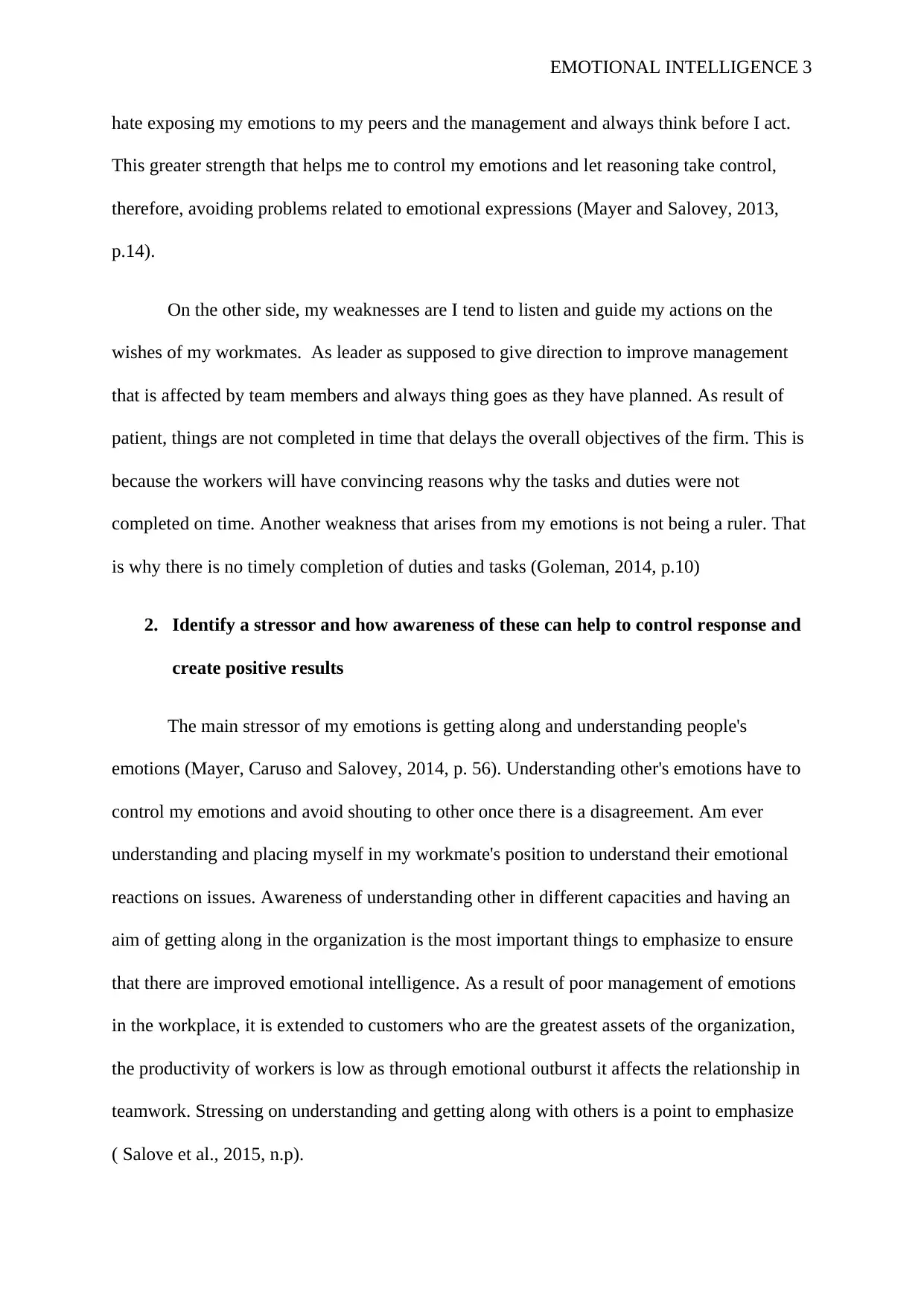
EMOTIONAL INTELLIGENCE 3
hate exposing my emotions to my peers and the management and always think before I act.
This greater strength that helps me to control my emotions and let reasoning take control,
therefore, avoiding problems related to emotional expressions (Mayer and Salovey, 2013,
p.14).
On the other side, my weaknesses are I tend to listen and guide my actions on the
wishes of my workmates. As leader as supposed to give direction to improve management
that is affected by team members and always thing goes as they have planned. As result of
patient, things are not completed in time that delays the overall objectives of the firm. This is
because the workers will have convincing reasons why the tasks and duties were not
completed on time. Another weakness that arises from my emotions is not being a ruler. That
is why there is no timely completion of duties and tasks (Goleman, 2014, p.10)
2. Identify a stressor and how awareness of these can help to control response and
create positive results
The main stressor of my emotions is getting along and understanding people's
emotions (Mayer, Caruso and Salovey, 2014, p. 56). Understanding other's emotions have to
control my emotions and avoid shouting to other once there is a disagreement. Am ever
understanding and placing myself in my workmate's position to understand their emotional
reactions on issues. Awareness of understanding other in different capacities and having an
aim of getting along in the organization is the most important things to emphasize to ensure
that there are improved emotional intelligence. As a result of poor management of emotions
in the workplace, it is extended to customers who are the greatest assets of the organization,
the productivity of workers is low as through emotional outburst it affects the relationship in
teamwork. Stressing on understanding and getting along with others is a point to emphasize
( Salove et al., 2015, n.p).
hate exposing my emotions to my peers and the management and always think before I act.
This greater strength that helps me to control my emotions and let reasoning take control,
therefore, avoiding problems related to emotional expressions (Mayer and Salovey, 2013,
p.14).
On the other side, my weaknesses are I tend to listen and guide my actions on the
wishes of my workmates. As leader as supposed to give direction to improve management
that is affected by team members and always thing goes as they have planned. As result of
patient, things are not completed in time that delays the overall objectives of the firm. This is
because the workers will have convincing reasons why the tasks and duties were not
completed on time. Another weakness that arises from my emotions is not being a ruler. That
is why there is no timely completion of duties and tasks (Goleman, 2014, p.10)
2. Identify a stressor and how awareness of these can help to control response and
create positive results
The main stressor of my emotions is getting along and understanding people's
emotions (Mayer, Caruso and Salovey, 2014, p. 56). Understanding other's emotions have to
control my emotions and avoid shouting to other once there is a disagreement. Am ever
understanding and placing myself in my workmate's position to understand their emotional
reactions on issues. Awareness of understanding other in different capacities and having an
aim of getting along in the organization is the most important things to emphasize to ensure
that there are improved emotional intelligence. As a result of poor management of emotions
in the workplace, it is extended to customers who are the greatest assets of the organization,
the productivity of workers is low as through emotional outburst it affects the relationship in
teamwork. Stressing on understanding and getting along with others is a point to emphasize
( Salove et al., 2015, n.p).
⊘ This is a preview!⊘
Do you want full access?
Subscribe today to unlock all pages.

Trusted by 1+ million students worldwide
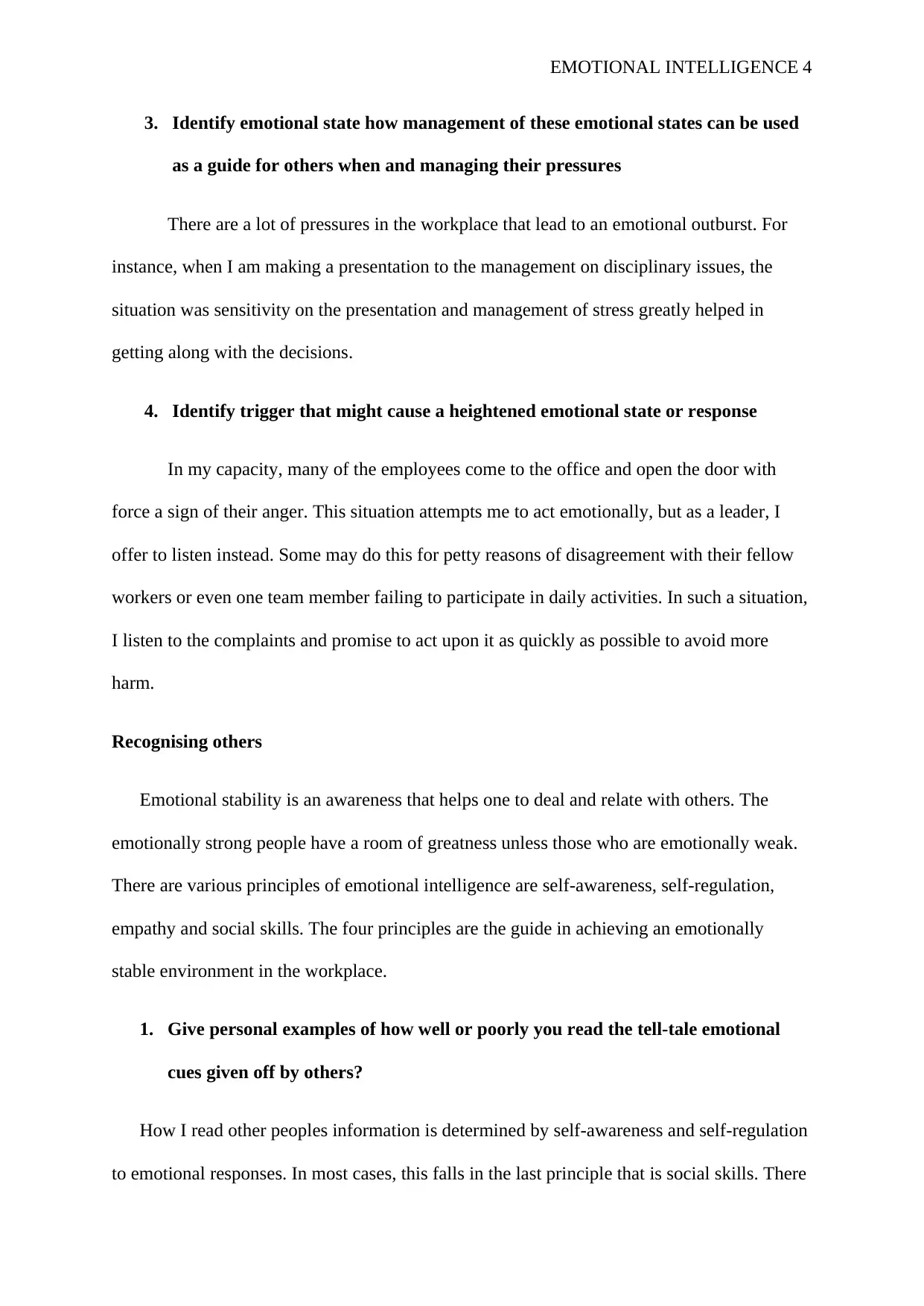
EMOTIONAL INTELLIGENCE 4
3. Identify emotional state how management of these emotional states can be used
as a guide for others when and managing their pressures
There are a lot of pressures in the workplace that lead to an emotional outburst. For
instance, when I am making a presentation to the management on disciplinary issues, the
situation was sensitivity on the presentation and management of stress greatly helped in
getting along with the decisions.
4. Identify trigger that might cause a heightened emotional state or response
In my capacity, many of the employees come to the office and open the door with
force a sign of their anger. This situation attempts me to act emotionally, but as a leader, I
offer to listen instead. Some may do this for petty reasons of disagreement with their fellow
workers or even one team member failing to participate in daily activities. In such a situation,
I listen to the complaints and promise to act upon it as quickly as possible to avoid more
harm.
Recognising others
Emotional stability is an awareness that helps one to deal and relate with others. The
emotionally strong people have a room of greatness unless those who are emotionally weak.
There are various principles of emotional intelligence are self-awareness, self-regulation,
empathy and social skills. The four principles are the guide in achieving an emotionally
stable environment in the workplace.
1. Give personal examples of how well or poorly you read the tell-tale emotional
cues given off by others?
How I read other peoples information is determined by self-awareness and self-regulation
to emotional responses. In most cases, this falls in the last principle that is social skills. There
3. Identify emotional state how management of these emotional states can be used
as a guide for others when and managing their pressures
There are a lot of pressures in the workplace that lead to an emotional outburst. For
instance, when I am making a presentation to the management on disciplinary issues, the
situation was sensitivity on the presentation and management of stress greatly helped in
getting along with the decisions.
4. Identify trigger that might cause a heightened emotional state or response
In my capacity, many of the employees come to the office and open the door with
force a sign of their anger. This situation attempts me to act emotionally, but as a leader, I
offer to listen instead. Some may do this for petty reasons of disagreement with their fellow
workers or even one team member failing to participate in daily activities. In such a situation,
I listen to the complaints and promise to act upon it as quickly as possible to avoid more
harm.
Recognising others
Emotional stability is an awareness that helps one to deal and relate with others. The
emotionally strong people have a room of greatness unless those who are emotionally weak.
There are various principles of emotional intelligence are self-awareness, self-regulation,
empathy and social skills. The four principles are the guide in achieving an emotionally
stable environment in the workplace.
1. Give personal examples of how well or poorly you read the tell-tale emotional
cues given off by others?
How I read other peoples information is determined by self-awareness and self-regulation
to emotional responses. In most cases, this falls in the last principle that is social skills. There
Paraphrase This Document
Need a fresh take? Get an instant paraphrase of this document with our AI Paraphraser
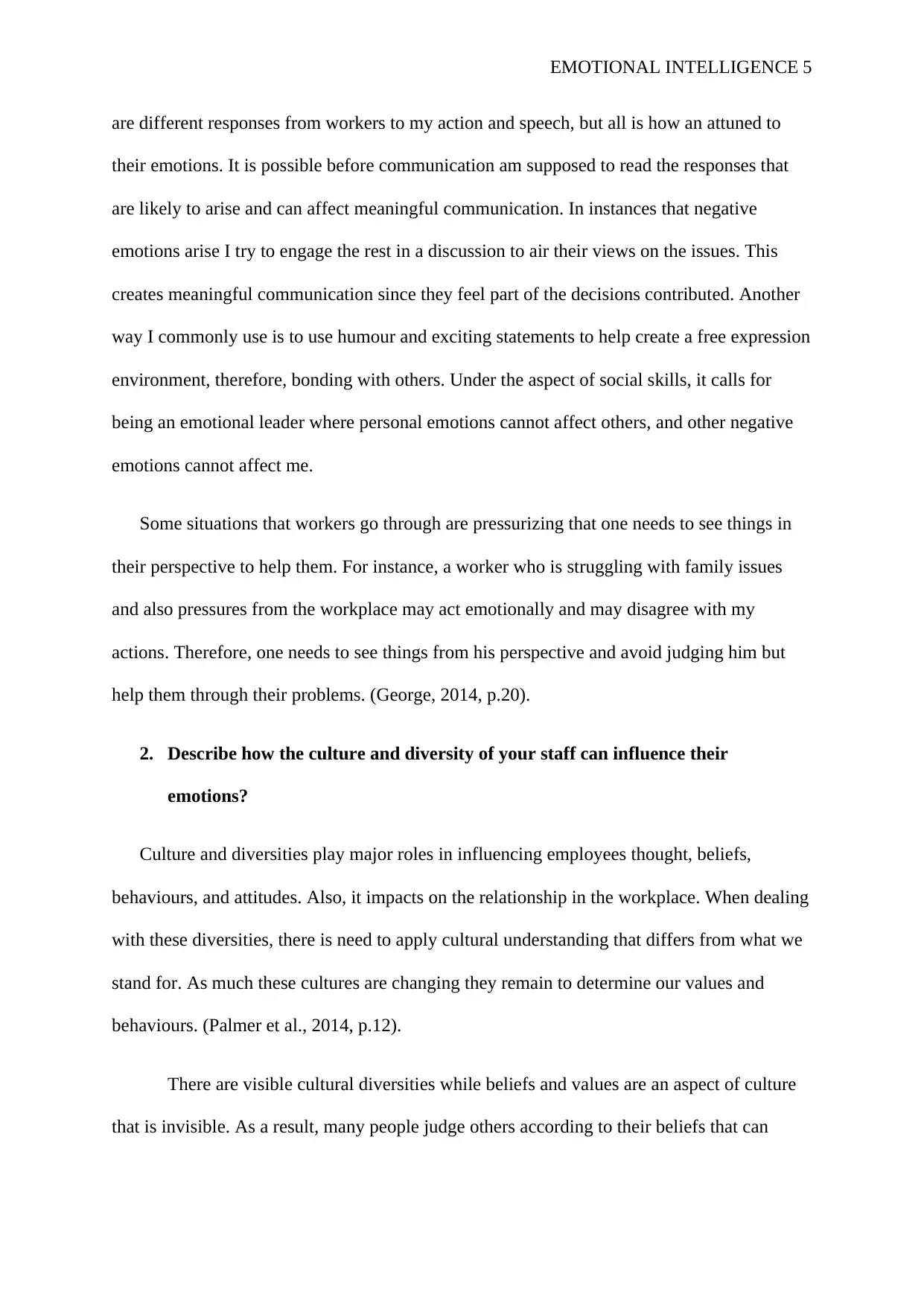
EMOTIONAL INTELLIGENCE 5
are different responses from workers to my action and speech, but all is how an attuned to
their emotions. It is possible before communication am supposed to read the responses that
are likely to arise and can affect meaningful communication. In instances that negative
emotions arise I try to engage the rest in a discussion to air their views on the issues. This
creates meaningful communication since they feel part of the decisions contributed. Another
way I commonly use is to use humour and exciting statements to help create a free expression
environment, therefore, bonding with others. Under the aspect of social skills, it calls for
being an emotional leader where personal emotions cannot affect others, and other negative
emotions cannot affect me.
Some situations that workers go through are pressurizing that one needs to see things in
their perspective to help them. For instance, a worker who is struggling with family issues
and also pressures from the workplace may act emotionally and may disagree with my
actions. Therefore, one needs to see things from his perspective and avoid judging him but
help them through their problems. (George, 2014, p.20).
2. Describe how the culture and diversity of your staff can influence their
emotions?
Culture and diversities play major roles in influencing employees thought, beliefs,
behaviours, and attitudes. Also, it impacts on the relationship in the workplace. When dealing
with these diversities, there is need to apply cultural understanding that differs from what we
stand for. As much these cultures are changing they remain to determine our values and
behaviours. (Palmer et al., 2014, p.12).
There are visible cultural diversities while beliefs and values are an aspect of culture
that is invisible. As a result, many people judge others according to their beliefs that can
are different responses from workers to my action and speech, but all is how an attuned to
their emotions. It is possible before communication am supposed to read the responses that
are likely to arise and can affect meaningful communication. In instances that negative
emotions arise I try to engage the rest in a discussion to air their views on the issues. This
creates meaningful communication since they feel part of the decisions contributed. Another
way I commonly use is to use humour and exciting statements to help create a free expression
environment, therefore, bonding with others. Under the aspect of social skills, it calls for
being an emotional leader where personal emotions cannot affect others, and other negative
emotions cannot affect me.
Some situations that workers go through are pressurizing that one needs to see things in
their perspective to help them. For instance, a worker who is struggling with family issues
and also pressures from the workplace may act emotionally and may disagree with my
actions. Therefore, one needs to see things from his perspective and avoid judging him but
help them through their problems. (George, 2014, p.20).
2. Describe how the culture and diversity of your staff can influence their
emotions?
Culture and diversities play major roles in influencing employees thought, beliefs,
behaviours, and attitudes. Also, it impacts on the relationship in the workplace. When dealing
with these diversities, there is need to apply cultural understanding that differs from what we
stand for. As much these cultures are changing they remain to determine our values and
behaviours. (Palmer et al., 2014, p.12).
There are visible cultural diversities while beliefs and values are an aspect of culture
that is invisible. As a result, many people judge others according to their beliefs that can
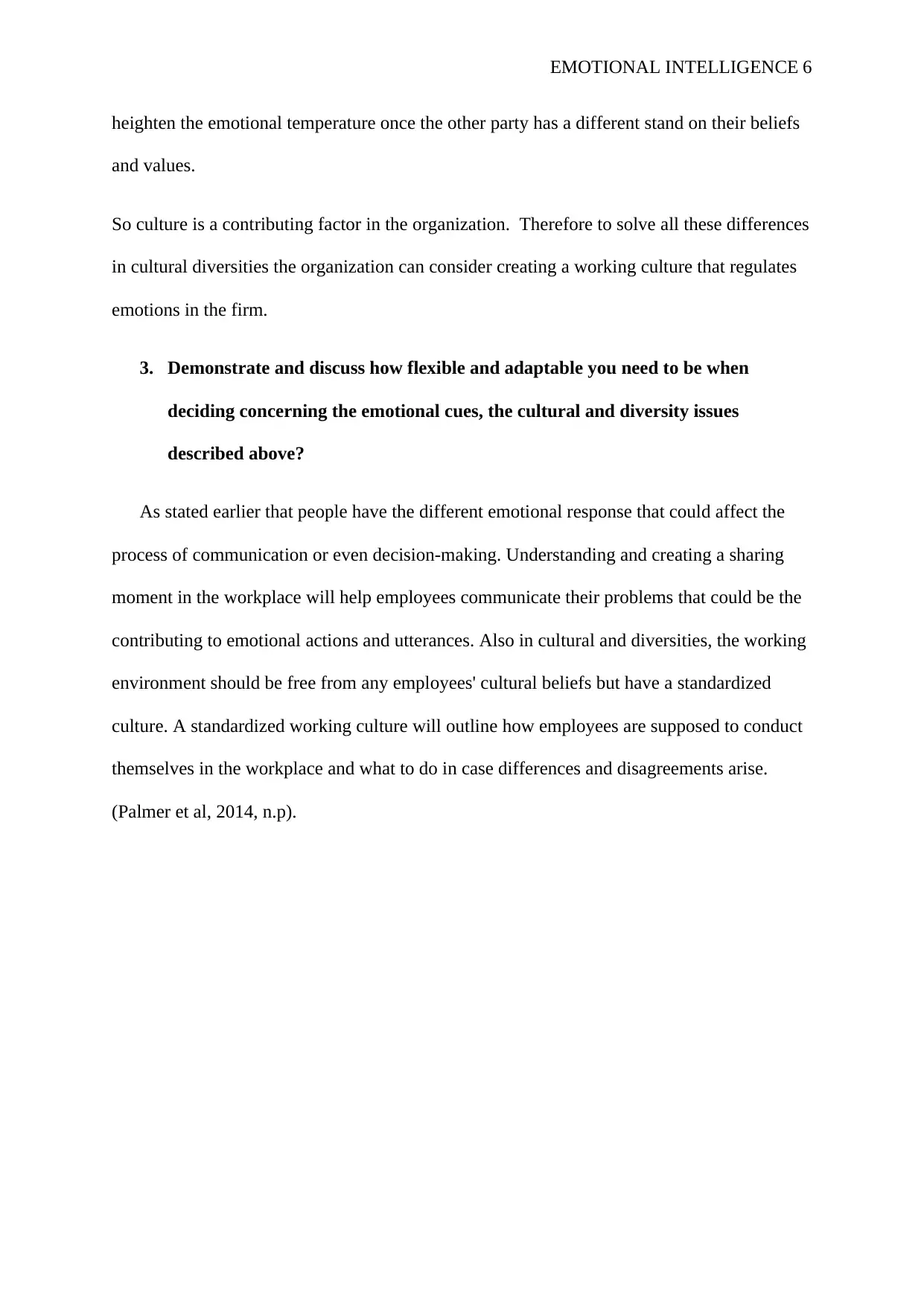
EMOTIONAL INTELLIGENCE 6
heighten the emotional temperature once the other party has a different stand on their beliefs
and values.
So culture is a contributing factor in the organization. Therefore to solve all these differences
in cultural diversities the organization can consider creating a working culture that regulates
emotions in the firm.
3. Demonstrate and discuss how flexible and adaptable you need to be when
deciding concerning the emotional cues, the cultural and diversity issues
described above?
As stated earlier that people have the different emotional response that could affect the
process of communication or even decision-making. Understanding and creating a sharing
moment in the workplace will help employees communicate their problems that could be the
contributing to emotional actions and utterances. Also in cultural and diversities, the working
environment should be free from any employees' cultural beliefs but have a standardized
culture. A standardized working culture will outline how employees are supposed to conduct
themselves in the workplace and what to do in case differences and disagreements arise.
(Palmer et al, 2014, n.p).
heighten the emotional temperature once the other party has a different stand on their beliefs
and values.
So culture is a contributing factor in the organization. Therefore to solve all these differences
in cultural diversities the organization can consider creating a working culture that regulates
emotions in the firm.
3. Demonstrate and discuss how flexible and adaptable you need to be when
deciding concerning the emotional cues, the cultural and diversity issues
described above?
As stated earlier that people have the different emotional response that could affect the
process of communication or even decision-making. Understanding and creating a sharing
moment in the workplace will help employees communicate their problems that could be the
contributing to emotional actions and utterances. Also in cultural and diversities, the working
environment should be free from any employees' cultural beliefs but have a standardized
culture. A standardized working culture will outline how employees are supposed to conduct
themselves in the workplace and what to do in case differences and disagreements arise.
(Palmer et al, 2014, n.p).
⊘ This is a preview!⊘
Do you want full access?
Subscribe today to unlock all pages.

Trusted by 1+ million students worldwide
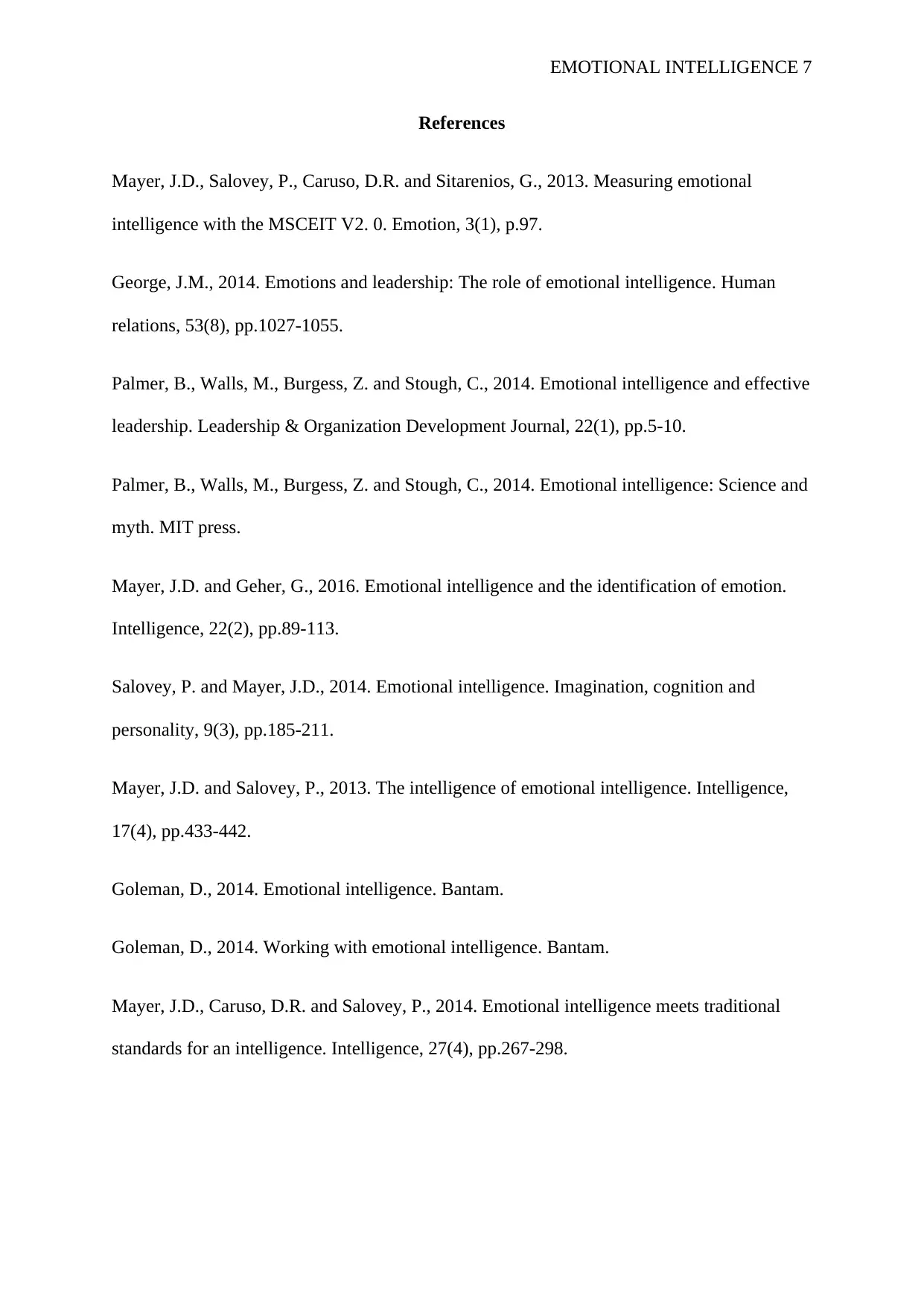
EMOTIONAL INTELLIGENCE 7
References
Mayer, J.D., Salovey, P., Caruso, D.R. and Sitarenios, G., 2013. Measuring emotional
intelligence with the MSCEIT V2. 0. Emotion, 3(1), p.97.
George, J.M., 2014. Emotions and leadership: The role of emotional intelligence. Human
relations, 53(8), pp.1027-1055.
Palmer, B., Walls, M., Burgess, Z. and Stough, C., 2014. Emotional intelligence and effective
leadership. Leadership & Organization Development Journal, 22(1), pp.5-10.
Palmer, B., Walls, M., Burgess, Z. and Stough, C., 2014. Emotional intelligence: Science and
myth. MIT press.
Mayer, J.D. and Geher, G., 2016. Emotional intelligence and the identification of emotion.
Intelligence, 22(2), pp.89-113.
Salovey, P. and Mayer, J.D., 2014. Emotional intelligence. Imagination, cognition and
personality, 9(3), pp.185-211.
Mayer, J.D. and Salovey, P., 2013. The intelligence of emotional intelligence. Intelligence,
17(4), pp.433-442.
Goleman, D., 2014. Emotional intelligence. Bantam.
Goleman, D., 2014. Working with emotional intelligence. Bantam.
Mayer, J.D., Caruso, D.R. and Salovey, P., 2014. Emotional intelligence meets traditional
standards for an intelligence. Intelligence, 27(4), pp.267-298.
References
Mayer, J.D., Salovey, P., Caruso, D.R. and Sitarenios, G., 2013. Measuring emotional
intelligence with the MSCEIT V2. 0. Emotion, 3(1), p.97.
George, J.M., 2014. Emotions and leadership: The role of emotional intelligence. Human
relations, 53(8), pp.1027-1055.
Palmer, B., Walls, M., Burgess, Z. and Stough, C., 2014. Emotional intelligence and effective
leadership. Leadership & Organization Development Journal, 22(1), pp.5-10.
Palmer, B., Walls, M., Burgess, Z. and Stough, C., 2014. Emotional intelligence: Science and
myth. MIT press.
Mayer, J.D. and Geher, G., 2016. Emotional intelligence and the identification of emotion.
Intelligence, 22(2), pp.89-113.
Salovey, P. and Mayer, J.D., 2014. Emotional intelligence. Imagination, cognition and
personality, 9(3), pp.185-211.
Mayer, J.D. and Salovey, P., 2013. The intelligence of emotional intelligence. Intelligence,
17(4), pp.433-442.
Goleman, D., 2014. Emotional intelligence. Bantam.
Goleman, D., 2014. Working with emotional intelligence. Bantam.
Mayer, J.D., Caruso, D.R. and Salovey, P., 2014. Emotional intelligence meets traditional
standards for an intelligence. Intelligence, 27(4), pp.267-298.
Paraphrase This Document
Need a fresh take? Get an instant paraphrase of this document with our AI Paraphraser
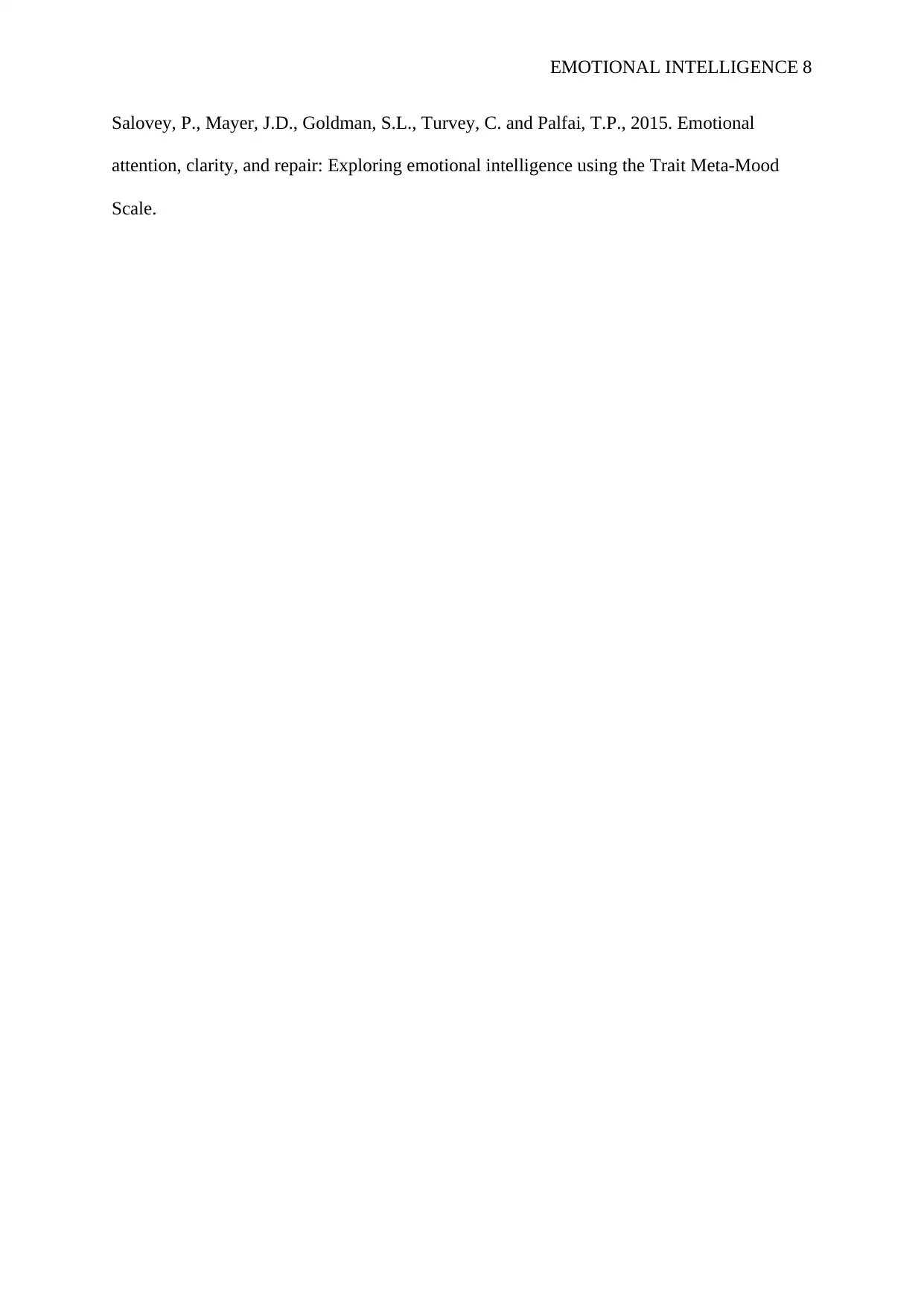
EMOTIONAL INTELLIGENCE 8
Salovey, P., Mayer, J.D., Goldman, S.L., Turvey, C. and Palfai, T.P., 2015. Emotional
attention, clarity, and repair: Exploring emotional intelligence using the Trait Meta-Mood
Scale.
Salovey, P., Mayer, J.D., Goldman, S.L., Turvey, C. and Palfai, T.P., 2015. Emotional
attention, clarity, and repair: Exploring emotional intelligence using the Trait Meta-Mood
Scale.
1 out of 8
Related Documents
Your All-in-One AI-Powered Toolkit for Academic Success.
+13062052269
info@desklib.com
Available 24*7 on WhatsApp / Email
![[object Object]](/_next/static/media/star-bottom.7253800d.svg)
Unlock your academic potential
Copyright © 2020–2025 A2Z Services. All Rights Reserved. Developed and managed by ZUCOL.




